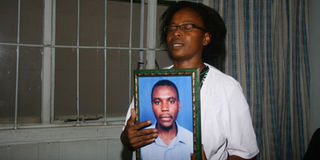Freedom for officials after close to two years in captivity

PHOTO | FILE The mother of Wajir DO Yesse Mule prays for her son on January 19, 2012, after he was abducted by Al-Shabaab militants. Mr Mule and another government officer, Mr Fredrick Wainaina, were freed on July 30, 2013.
What you need to know:
- During the abduction on January 12, 2012, about 100 Al-Shabaab fighters had attacked and destroyed an Administration Police camp at Gerille
Two officials who were abducted by Al-Shabaab have been freed after almost two years in captivity.
Mr Mule Yesse — who was captured in January 2012 in Wajir where he was District Officer, was released on Monday, his family confirmed.
Also freed was Mr Fredrick Irungu Wainaina, who works with the office of the Registrar of Persons.
The two are currently in Nairobi.
The Nation independently established that they were received by officers from the National Intelligence Service and the Directorate of Military Intelligence who spent most of Tuesday with them.
Mr Yesse’s father, Edward said: “I’ve not seen my son but I can confirm the information is true because I have been talking to him on phone since yesterday (Monday). We are waiting for a reunion later but it’s too early to give more information.”
Edward also shared the information with a friend through an SMS seen by the Nation.
It read: “I did not want you to hear it as part of the rumours. I am happy to inform you that my son was released yesterday. More details to follow. Our God is a God of wonders! Yesse.”
Another family member who requested not to be identified said relatives had been instructed not divulge the information.
During the abduction on January 12, 2012, about 100 Al-Shabaab fighters had attacked and destroyed an Administration Police camp at Gerille. Six Kenyans were killed in the raid which occurred barely three months after the Kenya Defence Forces entered Somalia to wage war against Al-Shabaab militants.
The terror group demanded that Kenya release its members who were being held on terrorism charges, including Kenyans who had been charged in Uganda, as a condition to have Mr Yasse and Mr Wainaina freed.
The group was referring to suspects who were on trial for the twin bomb attacks in Kampala in 2010, in which claimed more than 74 lives. The bombs went off in a club where a crowd was watching a World Cup match. At the time, the football tournament was being held in South Africa.
After the abductions, the military spokesman, Colonel Cyrus Oguna, said there were efforts to rescue the officials but he ruled out that the government would not negotiate with terrorists.
Final message
Al-Shabaab then posted a video in the internet titled “The final message” in which it threatened to execute the two.
There two appeared in the video together with two others who Al-Shabaab said were also Kenyans.
“Following the expiry of this period, all the kuffar (non-Muslim) Kenyan prisoners who appeared in the recent video will be executed,” read a post in Al-Shabaab’s official twitter account which has since been suspended.
In the video, Mr Yesse is seen reading from a script.
He said: “My dear Kenyans, my life and the lives of our fellow Kenyan prisoners depend on how you respond to this message. I am afraid that this may be the last message that you may hear from any of us in the near future. Please put yourselves in our shoes and consider the best possible course of action in securing our freedom.”
Al-Shabaab had given a February 14, 2012 deadline for Kenya to meet its demands.
According to the military at the time, there are 10 Kenyans held in captivity by Al-Shabaab, among them two soldiers and the two administrators.
The soldiers had been seized after they strayed nearly 100 kilometres into Somalia territory on a routine re-supply mission on the Kenyan-Somalia border town of Wajir. The two were abducted three months before the KDF incursion known as “Operation Linda Nchi” began. At that time, the military had increased its presence at the Kenya-Somalia border following earlier raids by Al-Shabaab.




